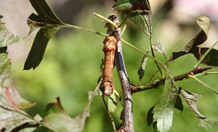
A twig-mimicking caterpillar of the Early Thorn moth
Caterpillars aren’t so bird brained after all
Caterpillars that masquerade as twigs to avoid becoming a bird’s dinner are actually using clever behavioural strategies to outwit their predators, according to a new study.
Researchers at the universities of Exeter, Liverpool, Liverpool Hope and Glasgow have shown that when it comes to the art of camouflage, things are never quite the way they seem.
The study, published online in the journal PNAS, reveals that twig-mimicking caterpillars choose their location to maximise their chances of fooling their predators into thinking they are twigs.
Using domestic chicks (gallus gallus domesticus) as predators of twig mimicking Early Thorn moth caterpillars (selenia dentaria), research showed that caterpillars are more likely to fool birds when twigs are common.
In order to exploit birds’ behaviour, caterpillars position themselves in locations where twigs are in abundance during the day – even if they’re not good locations for feeding.
At night, when the predators cannot hunt by sight, the caterpillars go to rich feeding grounds – regardless of twig abundance.
Dr John Skelhorn, a lecturer in animal behaviour at the University of Exeter and lead author of the study, said: “The caterpillars are not just blindly mimicking inedible objects in the environment and hoping for the best, they are actually using complex habitat-selection strategies which exploit predators’ hunting behaviour.
“In this study, we observed that the chicks were less likely to search for masquerading prey when the object they mimic, in this case twigs, is in abundance. It seems the low chances of finding prey and the amount of effort involved put them off.
“The caterpillars make the most of this by selecting habitats where twigs are common during the day, but then abandon them at night, when there are no visually-hunting predators around, in order to go in search of the best feeding grounds.”
To come to this conclusion, the researchers carried out a number of different trials using the chicks and caterpillars. In the trials, the team found that chicks exposed to situations where they had little success in checking twigs became less likely to look in the first place. When prey was hidden amongst a higher number of twigs, it also took the chicks much longer to find the caterpillars.
The research then looked at the behaviour of the caterpillars, placing them in an environment where they could choose between two branches – one with few twigs but plenty of food, and another with more twigs but no food.
Caterpillars showed a strong preference for the branch with lots of twigs, offering the best protection from their predators, during the daylight. At night, they opted for the food-rich branch.
Dr Skelhorn added: “This research shows that there are costs associated with masquerading as an inedible object. Caterpillars aren’t free to go where they want and have to select their locations very carefully. The benefit of masquerade is also determined by how many twigs are around, and how many other individuals are masquerading as twigs in the local environment.
“If there are too many masqueraders in one area, predators will learn this and be highly motivated to search for them. It really relies on there being not too many individuals trying to pull the same trick.
“The findings could inform conservation efforts for endangered masquerading species, such as the leafy sea dragon, as it is clear that the inedible objects these creatures resemble must remain abundant in order to protect them from predators.”
This research follows up on an earlier study involving Dr Skelhorn which showed predators mistake prey that mimic inedible objects in their local environment, such as twigs or stones, for the object that they resemble.
This work was supported by National Environment Research Council Grant (NERC) NE/E016626/1. The full study, Density-dependent predation influences the evolution and behaviour of masquerading prey, can be viewed online here.
You can see this story covered on MSN here.
Date: 6 April 2011
